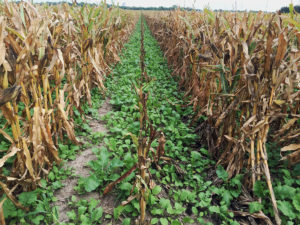 The 2019-2020 National Cover Crop Survey released this week found that despite the crippling rainfall that significantly delayed planting across much of the country in 2019, more than 90% of farmers participating reported that cover crops allowed them to plant earlier or at the same time as non-cover-cropped fields. Among those who had “planted green,” seeding cash crops into growing cover crops, 54% said the practice helped them plant earlier than on other fields.
The 2019-2020 National Cover Crop Survey released this week found that despite the crippling rainfall that significantly delayed planting across much of the country in 2019, more than 90% of farmers participating reported that cover crops allowed them to plant earlier or at the same time as non-cover-cropped fields. Among those who had “planted green,” seeding cash crops into growing cover crops, 54% said the practice helped them plant earlier than on other fields.
The survey, conducted by the non-profit Conservation Technology Information Center (CTIC), with financial support from the Sustainable Agriculture Research and Education (SARE) program and the American Seed Trade Association (ASTA), included perspectives from 1,172 farmers representing every state. It was the first by SARE, CTIC and ASTA to include detailed exploration of planting green—a tactic employed by 52% of the respondents—as well as crop insurance use among cover croppers and the impact of cover crops on the profitability of horticultural operations.
“We are pleased to see farmers appreciate the expertise of cover crop seed companies with 46% saying they buy from them and another 42% buying from retailers,” said Jane DeMarchi, VP Government & Regulatory Affairs, ASTA. “Professionally produced cover crop seed is grown for seed from the start and has been selected, harvested, cleaned and tested for performance. The study shows farmers are using a range of cover crop seed and mixes to address their individual needs with 46% paying $15 or under per acre.”
Among the 1,172 farmers who provided responses in the 2019-2020 National Cover Crop Survey, 81% were commodity producers (corn, soybeans, wheat, cotton, etc.) and 19% categorized themselves as horticultural producers.
